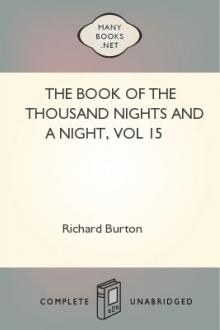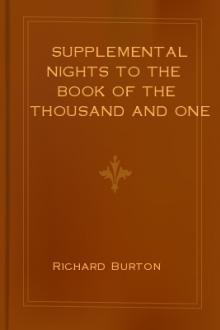The Book of the Thousand Nights and a Night, vol 15 by Sir Richard Francis Burton (classic romance novels .TXT) 📖

- Author: Sir Richard Francis Burton
- Performer: -
Book online «The Book of the Thousand Nights and a Night, vol 15 by Sir Richard Francis Burton (classic romance novels .TXT) 📖». Author Sir Richard Francis Burton
[FN#233] Lit. “The-Bull-(Taur for Thaur or Saur)numbered-and-for-battle-day-lengthened.” In p.30 this charger is called, “The-bull-that-spurneth-danger-on-battle-day.”
See vol. vi. 270 for a similar compound name, The-Ghul-who-eateth-man-we-pray-Allah-for-safety.
[FN#234] In text “Al-J�riyah r�dih,” the latter word being repeated in p.282, where it is R�dih a P.N. [Here also I would take it for a P.N., for if it were adjective to “al-J�riyah” it should have the article.—ST.]
[FN#235] The “Rad�f,” or back-rider, is common in Arabia, esp. on dromedaries when going to the Razzia: usually the crupper-man loads the matchlock and his comrade fires it.
[FN#236] The text has “thirty,” evidently a clerical error.
[FN#237] Arab. “Sakht�r” for “Shakht�r,” vol. vii. 362.
[FN#238] Doggerel fit only for the coffee-house.
[FN#239] In text “Ta’ayyun”=influence, especially by the “‘Ayn,”
or (Evil) Eye.
[FN#240] I have somewhat abridged the confession of the Princess, who carefully repeats every word known to the reader. This iteration is no objection in the case of a coffee-house audience to whom the tale is told bit by bit, but it is evidently unsuited for reading.
[FN#241] In text “Irham turham:” this is one of the few passive verbs still used in popular parlance.
[FN#242] This formula will be in future suppressed.
[FN#243] I spare my readers the full formula:—“Y�suf took it and brake the seal (fazza-hu) and read it and comprehended its contents and purport and significance: and, after perusing it,”
etc. These forms, decies repetita, may go down with an Eastern audience, but would be intolerable in a Western volume. The absence of padding, however, reduces the story almost to a patchwork of doggerel rhymes, for neither I nor any man can “make a silk purse from a suille ear.”
[FN#244] Here again in full we have:—“He mounted the she-camel and fared and ceased not faring until he drew near to the Palace of Al-Hayf�, where he dismounted and concealed his dromedary within the same cave. Then he swam the stream until he had reached the Castle and here he landed and appeared before Al-Hayf�,” etc.
[FN#245] “‘Tis dogged as does it” was the equivalent expression of our British Aristotle; the late Charles Darwin.
[FN#246] Arab. “Jannat al-Khuld”=the Eternal Garden: vol. ix.
214.
[FN#247] [I read: Wa inn� la-ar’�kum wa ar’� wid�da-kum, wa-hakki-kum� antum a’azzu ‘l-War� ‘and�=And I make much of you and of your love; by your rights (upon me, formula of swearing), you are to me the dearest of mankind.—ST.]
[FN#248] In text: “He swam the stream and bestrode his she-camel.”
[FN#249] In text “Then she folded the letter and after sealing it,” etc.
[FN#250] Not “her hands” after Christian fashion.
[FN#251] In text, “Ahyaf,” alluding to Al-Hayf�.
[FN#252] Arab. “Al-Kaw�‘ib,” also P. N. of the river.
[FN#253] This is moralising with a witness, and all it means is “handsome is that handsome does.”
[FN#254] In text “‘Arsh” = the Ninth Heaven; vol. v.167.
[FN#255] The Shi’ah doctrine is here somewhat exaggerated.
[FN#256] “Them” for “her,” as has often occurred.
[FN#257] In the original “entrusted to her the missive:” whereas the letter is delivered afterwards.
[FN#258] The cloud (which contains rain) is always typical of liberality and generous dealing.
[FN#259] The Koranic chapt. No. xx., revealed at Meccah and recounting the (apocryphal) history of Moses.
[FN#260] The “broken” (wall) to the North of the Ka’abah: Pilgrimage iii. 165.
[FN#261] i.e. “Delight of the Age:” see vol. ii. 81.
[FN#262] In the text written “Imriyyu ‘l-Kays”: for this pre-Islamitic poet see Term. Essay, p. 223. “The Man of Al-Kays”
or worshipper of the Priapus-idol was a marking figure in Arabian History. The word occurs, with those of Aera, Dusares (Theos Ares), Martabu, Allat and Man�t in the Nabath�an (Arabian) epigraphs brought by Mr. Doughty from Arabia Deserta (vol. i. pp.
180-184).
[FN#263] In text “Zakka,” which means primarily a bird feeding her young.
[FN#264] In the text “months and years,” the latter seeming de trop.
[FN#265] Or “Yathrib” = Al-Madinah; vol. iv. 114.
[FN#266] Scott (vi. 358 et seqq.) who makes Ali bin Ibrahim, “a faithful eunuch,” renders the passage, “by some accident the eunuch’s turban unfortunately falling off; the precious stones (N.B. the lovers’ gift) which, with a summary of the adventures (!) of Eusuff and Aleefa, and his own embassy to Sind, were wrapped in the folds, tumbled upon the floor,”
[FN#267] i.e. “Drawer-out of Descriptions.”
[FN#268] i.e. a Refuser, a Forbidder.
[FN#269] i.e. both could not be seen at the same time.
[FN#270] [The MS. has T Kh D H, which the translator reads “takhuz-hu.” I suspect that either the second or eighth form of “ahad” is meant, in the sense that thou comest to an agreement (Ittih�d) with him.—ST.]
[FN#271] In the MS. v. 327, we find four hemistichs which evidently belong to Al-Mihrj�n; these are:—
Hadet come to court her in fairer guise * I had given Al-Hayf� in bestest style;
But in mode like this hast thou wrought me wrong * And made Envy gibe me with jeering smile.”
Also I have been compelled to change the next sentence, which in the original is, “And hardly had King Al-Mihrj�n ended his words,” etc.
[FN#272] In this doggerel, “Kur�d” (apes) occurs as a rhyme twice in three couplets.
[FN#273] “Upon the poll of his head” (‘al� h�mati-hi) says the Arabian author, and instantly stultifies the words.
[FN#274] Arab. “Haudaj” = a camel-litter: the word, often corrupted to Had�j, is now applied to a rude pack-saddle, a wooden frame of mimosa-timber set upon a “witr” or pad of old tent-cloth, stuffed with grass and girt with a single cord. Vol.
viii. 235, Burckhardt gives “Maksar,” and Doughty (i. 437) “Muksir” as the modern Badawi term for the crates or litters in which are carried the Shaykhly housewives.
[FN#275] In text “Sunnah” = the practice, etc., of the Prophet: vol. v. 36, 167.
[FN#276] This, as the sequel shows, is the far-famed Musician, Ibrahim of Mosul: vol. vii. 113.
[FN#277] In the text King of Al-S�n=China, and in p. 360 of MS.
Yusuf is made “King of China and Sind,” which would be much like “King of Germany and Brentford.”
[FN#278] This is the full formula repeated in the case of all the ten blessed damsels. I have spared the patience of my readers.
[FN#279] This formula of the cup and lute is decies repetita, justifying abbreviation.
[FN#280] i.e. The Beginner, the Originator.
[FN#281] The Zephyr, or rather the cool north breeze of upper Arabia, vol. viii. 62.
[FN#282] The “Full Moon”; plur. Bud�r: vols. iii., 228, iv., 249.
[FN#283] “Dann” = amphora, Gr. {Greek} short for {Greek} = having two handles.
[FN#284] “The large-hipped,” a form of R�dih.
[FN#285] In text “Minba’ada-hu” making Jesus of later date than Imr al-Kays.
[FN#286] i.e. “The Delight”: also a P.N. of one of the Heavens: vols. iii. 19; iv. 143.
[FN#287] i.e. Joy, Contentment.
[FN#288] In text “L� khuzibat Ayday al-Fir�k,” meaning, “may separation never ornament herself in sign of gladness at the prospect of our parting.” For the Khaz�b-dye see vol. iii. 105.
[FN#289] i.e. “Bloom or the Tribe.” “Zahrat”=a blossom especially yellow and commonly applied to orange-flower. In line 10 of the same page the careless scribe calls the girl “Jauharat (Gem) of the Tribe.”
[FN#290] For this Hell, see vol. viii. 111.
[FN#291] “Core” or “Life-blood of Hearts.”
[FN#292] Presently explained.
[FN#293] In text “Afr�kh al-Jinn,” lit.=Chicks of the Jinns, a mere vulgarism: see “Farkh ‘Akrab,” vol. iv. 46.
[FN#294] “Ibr�a” = deliverance from captivity, etc. Y� = �, and M�m = m, composing the word “Ibrah�m.” The guttural is concealed in the Hamzah of Ibr�a, a good illustration of Dr. Steingass’s valuable remarks in Terminal Essay, pp. 235, 236.
[FN#295] “Kal�m” = one who speaks with another, a familiar.
Moses’ title is Kal�mu’llah on account of the Oral Law and certain conversations at Mount Sinai.
[FN#296] In text “Ist�f�” = choice, selection: hence Mustaf� =
the Chosen Prophet, Mohammcd; vols i. 7; ii. 40.
[FN#297] In text “Jazr” = cutting, strengthening, flow (of tide).
[FN#298] In the text “N�fishah” Pers. “N�fah,” derived, I presume, from “N�f” = belly or testicle, the part which in the musk-deer was supposed to store up the perfume.
[FN#299] For ‘Nah�vand,” the celebrated site in Al-Irak where the Persians sustained their final defeat at the hands of the Arabs A.H. 21. It is also one of the many musical measures, like the Ispah�ni, the R�sti, the Rayh�ni, the B�salik, the Nav�, etc., borrowed from the conquered ‘Ajam�.
[FN#300] This second half of the story is laid upon the lines of “The Man of Al-Yaman and his six Slave-girls”: vol. iv. 245.
[FN#301] This history again belongs to the class termed “Abtar =
tailless. In the text we find for all termination, “After this he (Y�suf) invited Mohammed ibn Ibrahim to lie that night in the palace.” Scott (vi. 364) ends after his own fashion:—“They (the ten girls) recited extempore verses before the caliph, but the subject of each was so expressive of their wish to return to their beloved sovereign, and delivered in so affecting a manner, that Mamoon, though delighted with their wit and beauty, sacrificed his own pleasure to their feelings, and sent them back to Eusuff by the officer who carried the edict, confirming him in his dominions, where the prince of Sind and the fair Aleefa continued long, amid a nnmerous progeny, to live the protectors of their happy subjects.”
[FN#302] This tale is headless as the last is tailless. We must suppose that soon after Mohammed ibn Ibrahim had quitted the Caliph, taking away the ten charmers, Al-Maamun felt his “breast straitened” and called for a story upon one of his R�w�s named Ibn Ahyam. This name is repeated in the text and cannot be a clerical error for Ibn Ibrahim.
[FN#303] Scott (vi. 366) “Adventures of the Three Princes, sons of the Sultan of China.”
[FN#304] In the text “‘Ajam,” for which see vol. i. 2, 120.
Al-Irak, I may observe, was the head-quarters of the extensive and dangerous Kh�rijite heresy; and like Syria has ever a bad name amongst orthodox Moslems.
[FN#305] In the Arab. “Salkh,” meaning also a peculiar form of circumcision, for which see Pilgrimage iii. 80-81. The Jew’s condition was of course a trick, presenting an impossibility and intended as a mere pretext for murdering an enemy to his faith.
Throughout the Eastern world this idea prevails, and both Sir Moses Montefiore and M. Cremieux were utterly at fault and certainly knew it when they declared that Europe was teaching it to Asia. Every Israelite community is bound in self-defence, when the murder of a Christian child or adult is charged upon any of its members, to court the most searching enquiry and to abate the scandal with all its might.
[FN#306] The text has “F� K�b,” which Scott (vol. vi. 367) renders “a mat.” [According to the Muh�t “K�b” is a small thick mat used to produce shade, pl. “Kiy�b” and “Aky�b.” The same authority says the word is of Persian origin, but this seems an error, unless it be related to “Keb” with the Y� majh�l, which in the Appendix to the Burh�ni K�ti’ is given as synonymous with “Pech,” twist, fold. Under “Bard�”==papyrus the Muh�t mentions that this is the material from which the mats known by the name of “Aky�b” are made.—ST.]
[FN#307] The text has here “Wasayah,” probably a clerical error for “wa Miah” (spelt M�yah”), and a hundred pair





Comments (0)